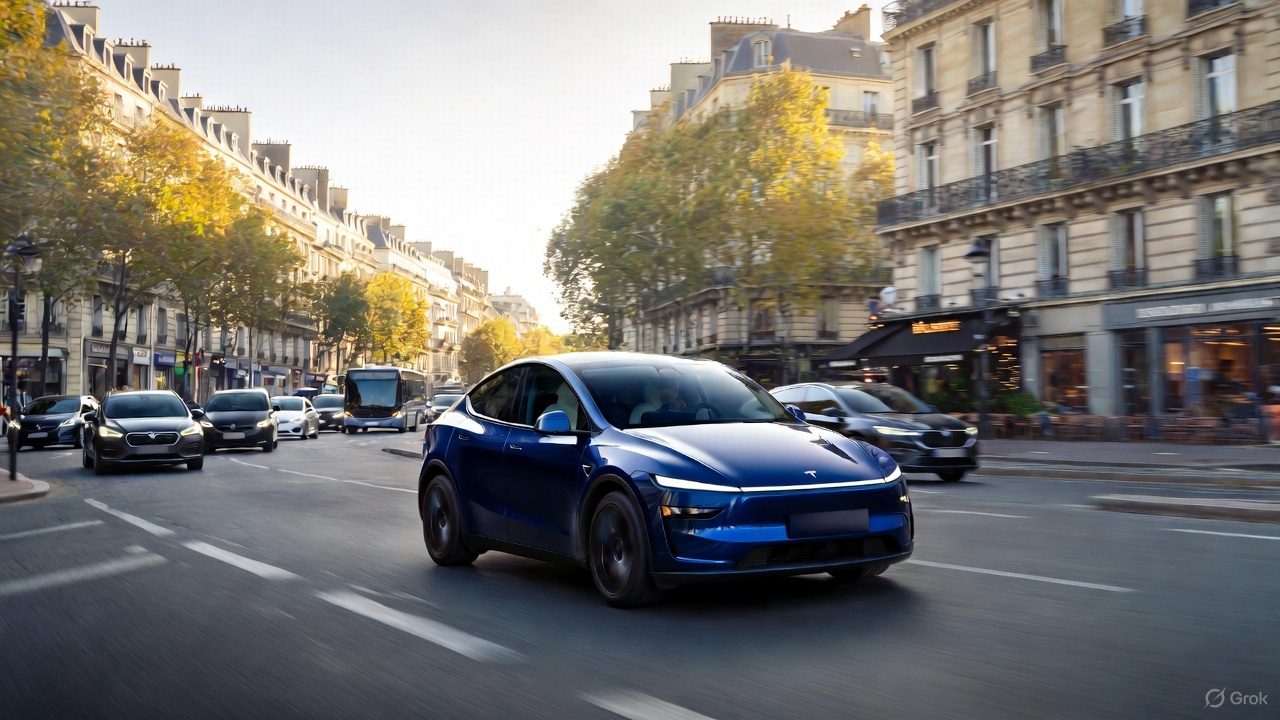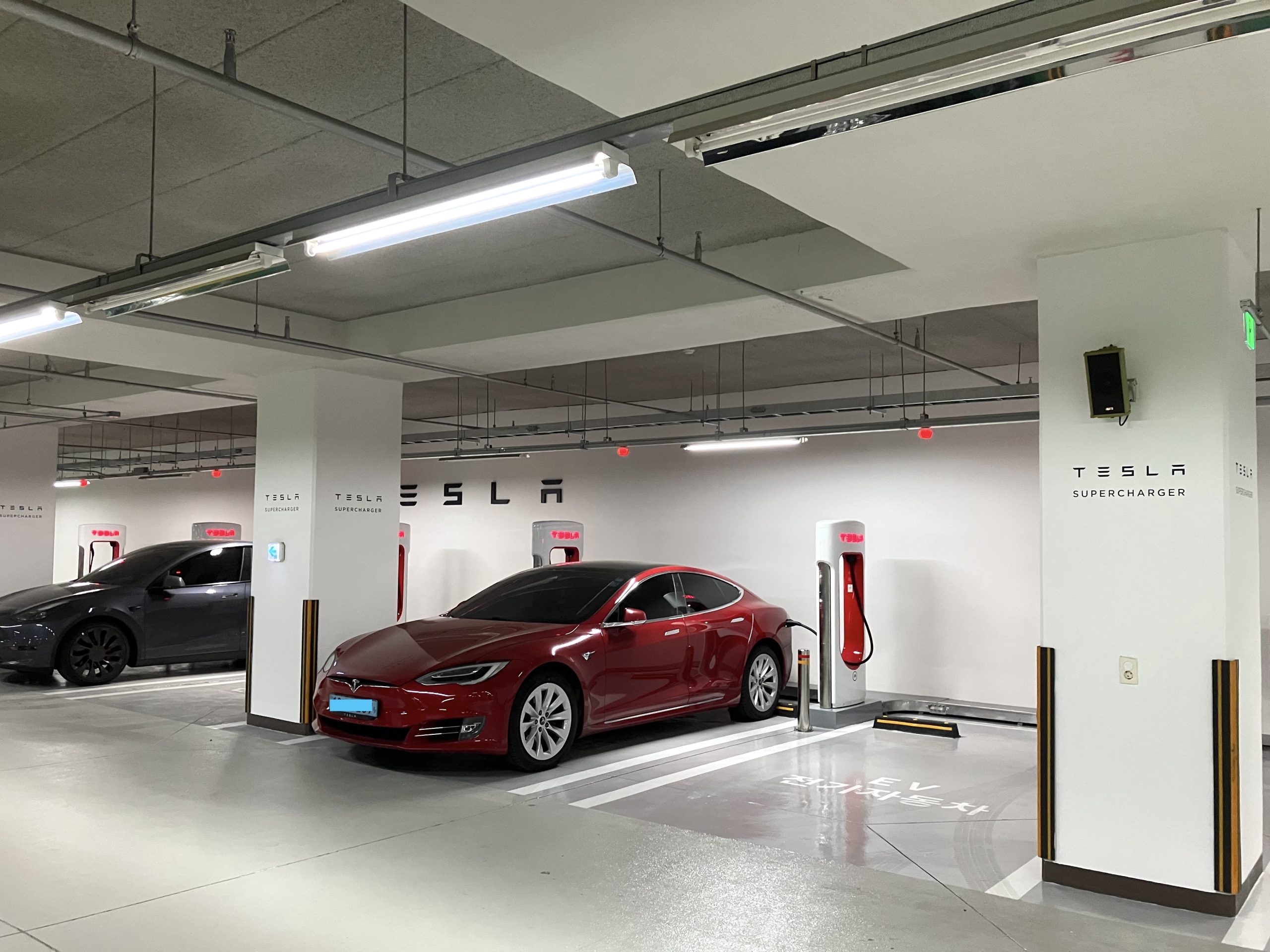As the auto industry transitions to electric vehicles (EVs), many have aired concerns that there will not be enough charging stations. According to one new report, many landlords and real estate owners in Los Angeles, California are rushing to construct new EV charging hardware at apartments, stores, office buildings and more.
Charging stations are not only considered a necessity for new housing developments in Los Angeles, according to the LA Times, but they’re also an opportunity for owners of convenience stores, fast food restaurants, gas stations, movie theaters and other retailers to make money while EV owners charge. Tesla and other companies are rapidly deploying new charging stations across the country, and the company recently built its 50,000th Supercharger stall.
Still, it’s difficult to say if the efforts to expand charging networks are enough, as many in the Los Angeles metro have pointed out.
One planning commissioner demanded project manager Hamid Behdad, who was overseeing a $350 million condominium skyscraper project in Los Angeles, to quadruple the number of charging stations at the project. Behdad eventually agreed to the last-minute change, now saying he’s “extremely glad that commissioner forced us” to build chargers at about 20 percent of the structure’s parking spots.
“When you are in the heat of the hearing in the last leg of the proposal, you aren’t going to say no,” Behdad said. “If we didn’t have these 90 chargers, we would be in real trouble selling units.”
As the demand for Tesla and other EVs continues to grow, many remain concerned about the state of the public charging infrastructure that will need to keep vehicles charged. The pace of EV adoption has accelerated rapidly in California, and it’s expected to follow suit throughout the U.S. in the coming years.
If demand wasn’t increasing enough on its own, California has also enacted a ban on the sale of new gas cars starting in 2035, and the move has since been followed by a number of states and even other countries.
One environmentally conscious housing developer, Cityview, is attempting to add as many charging stalls as allowed by a building’s electrical system. However, Cityview CEO Sean Burton notes that some older properties offer limited levels of available power supply for charging hardware, making it difficult.
“In general I think building owners are adopting more slowly than they should,” Burton said. “We try to be more leading edge on sustainability issues.”
ZRS Management, a property manager overseeing 76,000 apartment units is looking to retrofit power outlets in its garages to allow 210-volt, Level 2 charging, according to Vice President of Operations Jackie Impellitier. These systems can take roughly three to eight hours to charge an EV, and tenants have charging fees added to their utility bills.
“The thing we are all acknowledging is having charging stations is no longer an amenity, it’s a necessity,” Impellitier said of keeping tenants and garnering new ones. “We are going to start losing renters if we don’t have easy and convenient access” to chargers.
Several automakers, most recently including Jaguar, have signed on board to adopt Tesla’s North American Charging Standard (NACS), including plans to add the company’s charging port to their future EV releases. Ford was the first major automaker to adopt the equipment, as announced earlier this year in a Twitter Spaces call with Elon Musk. The company has since been joined by General Motors, Mercedes-Benz, Rivian, Hyundai, Honda and more.
What are your thoughts? Let me know at zach@teslarati.com, find me on X at @zacharyvisconti, or send your tips to us at tips@teslarati.com.

News
Man credits Grok AI with saving his life after ER missed near-ruptured appendix
The AI flagged some of the man’s symptoms and urged him to return to the ER immediately and demand a CT scan.

A 49-year-old man has stated that xAI’s Grok ended up saving his life when the large language model identified a near-ruptured appendix that his first ER visit dismissed as acid reflux.
After being sent home from the ER, the man asked Grok to analyze his symptoms. The AI flagged some of the man’s symptoms and urged him to return immediately and demand a CT scan. The scan confirmed that something far worse than acid reflux was indeed going on.
Grok spotted what a doctor missed
In a post on Reddit, u/Tykjen noted that for 24 hours straight, he had a constant “razor-blade-level” abdominal pain that forced him into a fetal position. He had no fever or visible signs. He went to the ER, where a doctor pressed his soft belly, prescribed acid blockers, and sent him home.
The acid blockers didn’t work, and the man’s pain remained intense. He then decided to open a year-long chat he had with Grok and listed every detail that he was experiencing. The AI responded quickly. “Grok immediately flagged perforated ulcer or atypical appendicitis, told me the exact red-flag pattern I was describing, and basically said “go back right now and ask for a CT,” the man wrote in his post.
He copied Grok’s reasoning, returned to the ER, and insisted on the scan. The CT scan ultimately showed an inflamed appendix on the verge of rupture. Six hours later, the appendix was out. The man said the pain has completely vanished, and he woke up laughing under anesthesia. He was discharged the next day.
How a late-night conversation with Grok got me to demand the CT scan that saved my life from a ruptured appendix (December 2025)
byu/Tykjen ingrok
AI doctors could very well be welcomed
In the replies to his Reddit post, u/Tykjen further explained that he specifically avoided telling doctors that Grok, an AI, suggested he get a CT scan. “I did not tell them on the second visit that Grok recommended the CT scan. I had to lie. I told them my sister who’s a nurse told me to ask for the scan,” the man wrote.
One commenter noted that the use of AI in medicine will likely be welcomed, stating that “If AI could take doctors’ jobs one day, I will be happy. Doctors just don’t care anymore. It’s all a paycheck.” The Redditor replied with, “Sadly yes. That is what it felt like after the first visit. And the following night could have been my last.”
Elon Musk has been very optimistic about the potential of robots like Tesla Optimus in the medical field. Provided that they are able to achieve human-level articulation in their hands, and Tesla is able to bring down their cost through mass manufacturing, the era of AI-powered medical care could very well be closer than expected.
News
Tesla expands Model 3 lineup in Europe with most affordable variant yet
The Model 3 Standard still delivers more than 300 miles of range, potentially making it an attractive option for budget-conscious buyers.

Tesla has introduced a lower-priced Model 3 variant in Europe, expanding the lineup just two months after the vehicle’s U.S. debut. The Model 3 Standard still delivers more than 300 miles (480 km) of range, potentially making it an attractive option for budget-conscious buyers.
Tesla’s pricing strategy
The Model 3 Standard arrives as Tesla contends with declining registrations in several countries across Europe, where sales have not fully offset shifting consumer preferences. Many buyers have turned to options such as Volkswagen’s ID.3 and BYD’s Atto 3, both of which have benefited from aggressive pricing.
By removing select premium finishes and features, Tesla positioned the new Model 3 Standard as an “ultra-low cost of ownership” option of its all-electric sedan. Pricing comes in at €37,970 in Germany, NOK 330,056 in Norway, and SEK 449,990 in Sweden, depending on market. This places the Model 3 Standard well below the “premium” Model 3 trim, which starts at €45,970 in Germany.
Deliveries for the Standard model are expected to begin in the first quarter of 2026, giving Tesla an entry-level foothold in a segment that’s increasingly defined by sub-€40,000 offerings.
Tesla’s affordable vehicle push
The low-cost Model 3 follows October’s launch of a similarly positioned Model Y variant, signaling a broader shift in Tesla’s product strategy. While CEO Elon Musk has moved the company toward AI-driven initiatives such as robotaxis and humanoid robots, lower-priced vehicles remain necessary to support the company’s revenue in the near term.
Reports have indicated that Tesla previously abandoned plans for an all-new $25,000 EV, with the company opting to create cheaper versions of existing platforms instead. Analysts have flagged possible cannibalization of higher-margin models, but the move aims to counter an influx of aggressively priced entrants from China and Europe, many of which sell below $30,000. With the new Model 3 Standard, Tesla is reinforcing its volume strategy in Europe’s increasingly competitive EV landscape.
News
Tesla FSD (Supervised) stuns Germany’s biggest car magazine
FSD Supervised recognized construction zones, braked early for pedestrians, and yielded politely on narrow streets.

Tesla’s upcoming FSD Supervised system, set for a European debut pending regulatory approval, is showing notably refined behavior in real-world testing, including construction zones, pedestrian detection, and lane changes, as per a recent demonstration ride in Berlin.
While the system still required driver oversight, its smooth braking, steering, and decision-making illustrated how far Tesla’s driver-assistance technology has advanced ahead of a potential 2026 rollout.
FSD’s maturity in dense city driving
During the Berlin test ride with Auto Bild, Germany’s largest automotive publication, a Tesla Model 3 running FSD handled complex traffic with minimal intervention, autonomously managing braking, acceleration, steering, and overtaking up to 140 km/h. It recognized construction zones, braked early for pedestrians, and yielded politely on narrow streets.
Only one manual override was required when the system misread a converted one-way route, an example, Tesla stated, of the continuous learning baked into its vision-based architecture.
Robin Hornig of Auto Bild summed up his experience with FSD Supervised with a glowing review of the system. As per the reporter, FSD Supervised already exceeds humans with its all-around vision. “Tesla FSD Supervised sees more than I do. It doesn’t get distracted and never gets tired. I like to think I’m a good driver, but I can’t match this system’s all-around vision. It’s at its best when both work together: my experience and the Tesla’s constant attention,” the journalist wrote.
Tesla FSD in Europe
FSD Supervised is still a driver-assistance system rather than autonomous driving. Still, Auto Bild noted that Tesla’s 360-degree camera suite, constant monitoring, and high computing power mark a sizable leap from earlier iterations. Already active in the U.S., China, and several other regions, the system is currently navigating Europe’s approval pipeline. Tesla has applied for an exemption in the Netherlands, aiming to launch the feature through a free software update as early as February 2026.
What Tesla demonstrated in Berlin mirrors capabilities already common in China and the U.S., where rival automakers have rolled out hands-free or city-navigation systems. Europe, however, remains behind due to a stricter certification environment, though Tesla is currently hard at work pushing for FSD Supervised’s approval in several countries in the region.










